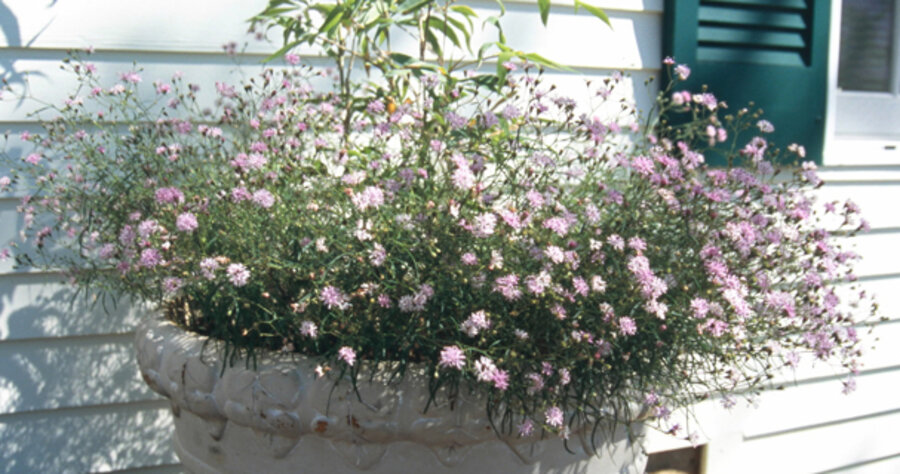Let Your Container Gardens Go Native
Loading...
Although not listed on any big board of international assets, the United States’ pool of native plants is highly prized among gardeners and horticulturists throughout the world. And now North American plants – from asters to coneflowers, from liatris to evening primrose – are also leaping into new prominence in container gardens.
“These small gardens are a perfect way to use natives when space is at a premium or to try out a native species before planting it in a border.... Move mature plants to your garden where the colorful flowers will continue to attract both butterflies and hummingbirds,” Alan Branhagen, director of horticulture for Powell Gardens, wrote for the website of the Prairie & Wetland Center in Belton, Mo.
While purists grow only those species that are indigenous within 100 miles of their own gardens, other gardeners approach native plant projects in a more relaxed way. For them, it is enough that the plants are native to their general regions, and they are equally likely to choose cultivars, selected or specially bred plants derived from native species.
Finding native plants
Whichever path you choose, you will increasingly find nurseries and growers that specialize in all sorts of native plants. Organizations [see list here] dedicated to native plants exist throughout the country and an inexpensive membership in one or more of these groups will give you an inside track to finding and growing natives. Other good sources of information on native plants are state extension services.
Always remember the first commandment of gardening with native species: Thou shalt not dig wild plants – buy them from nurseries that have propagated them lawfully or start them from seed that you have gathered.
I look to people like Merv Wallace of Missouri Wildflowers Nursery for advice on species. Having grown natives for 23 years, he knows what he’s talking about. His catalog is an education on Midwestern native species. In it he writes: “Many homeowners hesitate to use native plants in their front yard landscaping because there is a myth that natives look too weedy.”
He goes on to say that many worthy natives have a refined shape, attractive foliage, and showy flowers. These are four-star plants in the rating system that Mr. Wallace is developing to help gardeners choose natives.
Although the one-star plants are the weediest, they, too, have value, often for wildlife. For example, the rambling New England aster is a wonderful nectar source for migrating monarch butterflies.
Planting natives in containers
Growing ornamental plants in containers expands planting areas, adds color, and raises gardening levels. Growing in large pots also allows many condominium and apartment dwellers to grow natives.
Container gardening provides imaginative and effective ways to create small native gardens with esthetic charm and plant appeal – gardens that echo the woodlands, meadows, and prairies of the American countryside.
Choose containers to reflect the themes of native plants, pioneer times, or the past cultural history of a particular region. Washtubs, half barrels, window boxes, and boxes made of rough lumber are just a few of the choices. (Be sure they include drainage holes.)
As in all gardening, one of the keys to success in growing natives is matching plants with your environment. (Place plants that can’t take the sun in a shady area and plants that prefer moist soil where you can keep them well-watered.)
For planters in full sun, choose natives of prairies, glades, and open fields. For shadier sites, choose woodland natives, plants that naturally grow in dappled shade. Plan to group plants that have the same cultural requirements together in the same planter.
NATIVE PLANTS THAT DO WELL IN CONTAINERS
Sunny sites
False or wild blue indigo (Baptisia australis). Bushy perennial grows to three feet and bears blue flower spikes in late spring to early summer.
Golden coreopsis (Coreopsis tinctoria). Summer-blooming, reseeding annual, about three feet tall and has daisylike golden flowers.
Prairie dropseed (Sporobolus heterolepis). Perennial prairie grass growing to 15 inches high and crowned by 30-inch summer flower stalks.
Purple poppy mallow (Callirhoe involucrata). A perennial about three feet tall that bears deep reddish flowers in late spring to early summer.
Rose verbena (Glandularia canadensis). Low-growing, reseeding annual bears clumps of lilac-pink flowers during summer months.
Showy evening primrose (Oenothera speciosa). Low-growing 1- to 1-1/2-foot perennial that bears pink, sometimes white flowers in late spring to early summer.
Tall phlox (Phlox paniculata). Perennial, two- to four-foot summer-blooming plant with purple to rose to pink to (occasionally) white flowers.
Shady Sites
Alumroot (Heuchera villosa). Perennial, up to two feet tall, with stalks of small white or pink flowers on tall stems.
Christmas fern (Polystichum acrostichoides). Low-growing, nearly evergreen, perennial fern with handsome fronds and a tidy habit.
Indian pink (Spigelia marilandica). Perennial, up to 2 feet tall, with late-spring clumps of tubular flowers that are red outside and yellow inside.
Jacob’s ladder (Polemonium reptans). Low-growing perennial bears clumps of spring flowers in shades of pale blue to blue-lavender.
Lady fern (Athyrium filix-femina). Perennial deciduous fern, up to three feet tall, with long feathery fronds.
Wild geranium (Geranium maculatum). Perennial, about two feet tall, with late spring to early summer pink flowers.
Wild ginger (Asarum canadense). Low-growing perennial known for its handsome foliage. Brownish spring flowers hidden in leaves.





